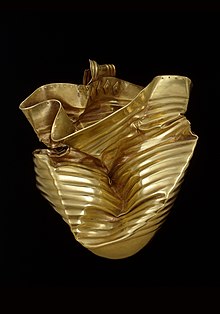| Ringlemere Cup | |
|---|---|
 | |
| Material | Gold |
| Created | 1700-1500 BC |
| Discovered | Ringlemere barrow in 2001 |
| Present location | British Museum |
The Ringlemere Gold Cup is a Bronze Age vessel found in the Ringlemere barrow near Sandwich in the English county of Kent in 2001. Its discovery marked the beginning of research into and excavation of ring marks in the surrounding soil and what was later termed the Ringlemere Barrow. This find inspired further research by the British Museum and others into the connection between the Ringlemere Cup and others like it, published as a book in 2006.
Contents
- Description
- Discovery, purchase and display
- Loans
- The Ringlemere Cup book
- See also
- Notes
- References
- External links
It is thought that the cup was not a grave good, but a votive offering independent of any inhumation, which was placed at the centre of the barrow in about 1700–1500 BC. No contemporary burials have been found at the site, although later Iron Age ones have since been found, along with an Anglo-Saxon cemetery.
Only seven similar gold "unstable handled cups" (unstable because round-bottomed) have been found in Europe, all dating to the period between 1700 and 1500 BC. The Ringlemere cup is most similar to the other British example, the Rillaton gold cup found in Cornwall in 1837. The other examples are two from Germany, two from Switzerland, one now lost from Brittany, and an unprovenanced, perhaps German, example. Two other silver cups and, from Britain, two amber and some shale cups all share the same basic shapes (see Hove amber cup). The finds in Britain are in the approximate Wessex area, and on the continent near the Rhine or the Channel coast, suggesting that the vessels, though probably all made fairly locally to their find spots, related to a specific cross-channel trading zone. [1]
The cup is usually on display in Room 2 of the Prehistory Galleries in the British Museum, Bloomsbury, London. However, as a popular gold piece, it is sometimes loaned to exhibitions.


